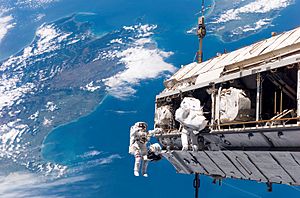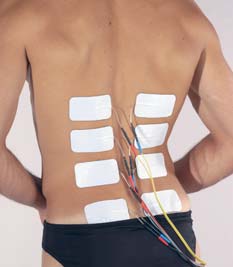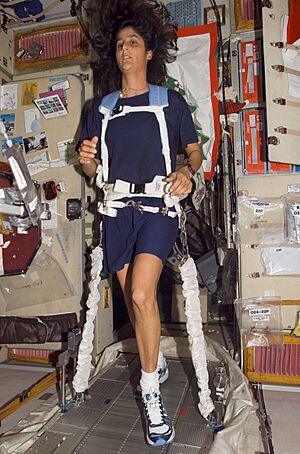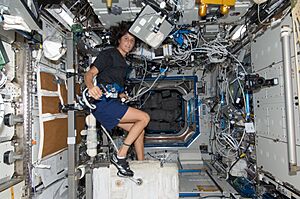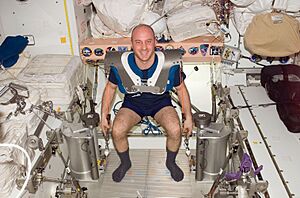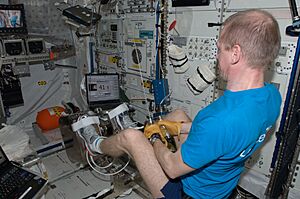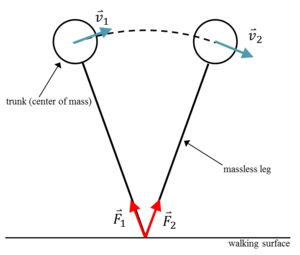Locomotion in space facts for kids
Moving around in space means all the ways astronauts use to move their bodies when there's no gravity, like in outer space. Moving in these conditions is very different from moving on Earth where gravity pulls you down. Many things make it different, and understanding them is super important for figuring out how humans can live in space for a long time.
Contents
Why is Moving in Space So Hard?
Humans grew up on Earth with its normal gravity. So, when astronauts go into space where there's very little gravity (called microgravity or weightlessness), it can have big effects on their bodies and how they move.
Space Environment Challenges
The conditions in space are really tough. Astronauts need lots of special gear to survive and do their daily tasks. There are many things to think about, both inside and outside a spacecraft. These include how to move when you're weightless, the equipment needed to travel, and special suits that make it hard to move.
When astronauts go on spacewalks, they must be safe from the vacuum of space. Being exposed to this harsh environment can be deadly very quickly. The main dangers in space include:
- No oxygen to breathe.
- Huge differences in pressure and temperature.
- Higher levels of radiation that can harm the body.
How Space Affects the Body
Spending a long time in space with little gravity can have many bad effects. These effects are similar to getting older or having certain diseases. Some long-term effects of weightlessness can even be copied on Earth by having people stay in bed rest. These effects include:
- Muscles getting weaker and smaller.
- The body getting out of shape (like blood vessels tightening or bones losing strength).
- Symptoms that look like aging or sickness.
- Fluids moving up to the head (causing headaches, stuffy nose, or a puffy face).
- Less muscle size.
- Bones becoming weaker and more likely to break.
- Feeling more tired and losing overall strength.
- Less control over how you move.
- Feeling motion sickness.
- Problems with eyesight.
- Other physical and even psychological effects.
Muscles can shrink by up to 20% during a six-month space mission. Bone strength in the hip can drop by about 1.4% each month. Scientists have studied how long space flights (around 180 days) affect leg muscles. They found that long periods of weightlessness caused a big loss in the size, strength, and power of calf muscles. Many ways exist to fight these effects, but they aren't enough yet. Astronauts need a lot of physical therapy when they return to Earth.
Cool Tech to Help Astronauts
To help astronauts deal with the bad effects of long periods in weightlessness, scientists have created many special technologies. Some work better than others.
Electrical Muscle Stimulation
Electrical muscle stimulation (EMS) uses small electric currents to make muscles move. The idea is to stop muscles from getting weak and small. One study in 1989 looked at people who stayed in bed for 30 days. Even though their stimulated leg muscles didn't shrink as much, it wasn't clear if this method would fully stop the effects. More recently, in 2003, another study showed that EMS did help prevent muscle weakness caused by not using the muscles. Several studies suggest EMS could be used on long space flights.
Special Loading Suits
Loading suits are clothes designed to help keep pressure on bones while in space. These are different from space suits, which help astronauts survive the harsh environment outside a spacecraft like the International Space Station (ISS).

The Pingvin Suit
The Pingvin exercise suit is made to put pressure on specific muscle groups, especially in the back, during space flight. This helps stop those muscles from getting weak. This light suit has elastic bands that create a downward force on the body. It can put pressure on the upper and lower body separately. The upper body can feel up to 88 pounds (40 kg) of pressure. Astronauts have found this suit to be hot and uncomfortable, even though it's light.
Gravity Loading Countermeasure Skinsuit (GLCS)
The GLCS is another suit designed to help prevent muscles and bones from getting weak. It was partly inspired by the Russian Pingvin suit. This skinsuit uses elastic materials to put pressure on the body, trying to copy the feeling of gravity on Earth. A first test was done in 2009 during special flights that create weightlessness. This suit creates more pressure towards the feet, like gravity does. Newer versions of the suit are now being tested on the ISS by the European Space Agency.
Other Suit Ideas
- DYNASUIT concept: This is a design idea for a suit that would have many parts. Each part would control something different. For example, one part would measure things like muscle signals, heart rate, and body temperature. It would also have a "brain" unit and a system using special materials or air pressure to apply forces to the body. There would also be a screen for the astronaut to use. This suit is still just an idea and hasn't been built yet.
Medicine to Help
Generally, a person's body absorbs medicine very differently in weightlessness compared to on Earth. Also, various medicines are used to help with certain side effects of long space flights. For example, NASA has used a medicine called dextroamphetamine to help with space motion sickness. Another medicine, alendronate, has been suggested to help prevent bone loss, but it's not yet proven to work for this.
Creating Artificial Gravity
Artificial gravity (AG) means making a force that feels like gravity using artificial methods. Different forces, like spinning or speeding up in a straight line, can create this feeling of gravity.
Using artificial gravity to fight the effects of fake weightlessness (like bed rest) on Earth has shown mixed results for keeping bones, muscles, and the heart healthy. Small spinning machines called centrifuges can create forces stronger than gravity. These could help prevent muscle and bone loss from long space flights or bed rest. One study in 2008 compared two groups: one stayed in bed for 21 days (to copy space travel effects), and the other also stayed in bed but was exposed to artificial gravity for one hour a day using a centrifuge. The group that used artificial gravity showed less muscle loss.
Even though this technology could help, it's hard to use artificial gravity systems in space. Spinning an entire spacecraft is expensive and makes the design much more complex. A smaller centrifuge can be used for short periods, but the exercises you can do in a small centrifuge are limited because it has to spin very fast to create enough gravity. Astronauts can also feel dizzy or sick in the centrifuge.
Some studies suggest that artificial gravity could be a good way to fight the effects of long space flights, especially if combined with other methods. One idea from 2005, called ViGAR (Virtual Gravity Artificial Reality), describes a device that mixes artificial gravity, exercise, and virtual reality. It includes a bicycle on a spinning platform and a virtual reality system.
Exercise in Space
Treadmill Vibration Isolation and Stabilization (TVIS)
The TVIS is a special treadmill. It has a system that stops the forces from exercising from shaking the International Space Station (ISS). It works much like a regular treadmill. To keep the astronaut on the treadmill, it uses a system of straps and bungee cords. These straps pull down on the astronaut's body with a force between 40 and 220 pounds as they walk or run.
Cycle Ergometer with Vibration Isolation (CEVIS)
The CEVIS helps astronauts do aerobic and heart-strengthening exercises using a stationary bike. The amount of effort needed can be set very precisely. Astronauts can set goals for speed, effort, and heart rate. It's a changed version of another bike. It has a control panel that shows the target effort, actual effort, cycling speed, heart rate, and how long they've been exercising. The effort range is between 25 and 350 Watts. The pedal speeds can be from 30 to 120 revolutions per minute. It also has a system that stops the exercise movements from shaking the International Space Station (ISS).
The CEVIS is currently used on the International Space Station as part of the astronauts' weekly exercise plan. It is built to last for 15 years in space.
Interim Resistance Exercise Device (iRED)
The iRED helps astronauts do exercises that build strength. This helps prevent muscles from getting weak and bones from losing strength. It focuses on keeping the astronaut's strength, power, and endurance. It offers over 18 different exercises for both the upper and lower body and can provide up to 300 pounds of resistance. Examples of exercises include squats, deadlifts, heel raises, bicep curls, and shoulder presses.
It was used daily as part of the crew's exercise routine but was replaced in October 2011. Now, the Advanced Resistive Exercise Device (ARED) is used.
Other Exercise Devices for Space
- Flywheel exercise device (FWED)
- Multi-purpose Integrated Countermeasures Stimulator (M-ICS)
- Resistive Vibration Exercise
- Integrated Countermeasure and Rehabilitation Exerciser (ICARE)
- Short Arm Human Centrifuge
- Lower Body Negative Pressure Exercise (LBNP)
How Well Do These Methods Work?
The TVIS and iRED are mostly not very good at keeping muscle size and bone strength. Both the TVIS and iRED cannot create forces that are similar to what you feel on Earth. The harnesses and bungee cords used in many of these devices are quite uncomfortable. They need to be redesigned to be easier to use for long periods. The CEVIS, at its highest setting, is the only permanent device on the ISS that can create resistance similar to Earth's gravity. The FWED (used on the ISS in 2009) was shown to create forces stronger than body weight and helped reduce bone and muscle weakness.
The European Space Agency uses many different tools to check how well these technologies work.
How We Move in Space
Gravity greatly affects how fast we walk, how our muscles work, when we switch from walking to running, and how we move in general. This means we need to study how movement works in space to make it as good as possible.
On Earth, scientists use something called the "dynamic similarity hypothesis" to compare how different people walk. This idea says that different mammals move in a similar way when they travel at a speed where the forces from their movement are in the same ratio to the forces of gravity. This ratio is called the Froude number. It's a number that helps compare how animals of different sizes and types move. The Froude number depends on a person's mass, leg length, speed, and gravity. For humans on Earth, it usually shows when a person switches from walking to running, which is around 0.5. In lower gravity, people switch to running at slower speeds, but still at about the same Froude number.
When studying movement in space, these rules don't always apply. For example, the "inverted pendulum model" for walking might not work in low gravity. Also, when wearing a space suit, the Froude number changes a lot. Scientists at MIT created a new number called the "Apollo number" in 2009. The Apollo number considers the weight the space suit supports and the difference in gravity. While it doesn't explain everything about walking in a space suit, it accounts for 60% of the difference. This could help a lot in designing better space suits in the future.
Energy Used for Moving in Space
On Earth, it takes about half as much energy to walk a mile as it does to run the same distance. But when wearing a space suit in low gravity, running actually uses less energy than walking! Generally, walking in low gravity uses a lot of energy. This means that the way people normally walk is disrupted in this environment. When running in low gravity, the energy used by the body goes down as body weight goes down. This and other evidence suggest that space suits act like springs when running. This would make it easier to move compared to walking. A study suggested that this spring-like behavior comes from how the knee bends. The more the knee bends, the more the space suit helps.
The limits on spacewalks are related to how much energy it takes to move in a space suit. How much energy you use for a physical activity is called its "metabolic cost." When thinking about future space missions and building colonies, these limits on spacewalks are important. The biggest things that affect how much energy is used when moving in a space suit are the suit's pressure, gravity, speed, the slope of the surface, and the suit's design.
See also
- Locomotion
- Space colonization
- Mars suit


